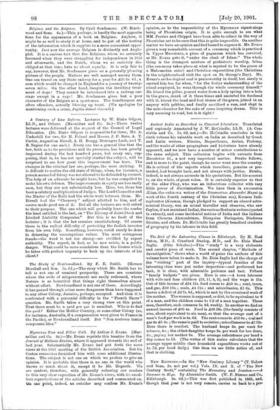The Diet of the LaboUring Classes in Edinburgh. By H.
Noel Paton, M.D., .T. Craufurd Dunlop, M.D., and Dr. Elsie Maud Inglis. (Otto Schulze.)—This " study " is a very elaborate and careful piece of work. The second chapter, "Methods of Investigation," shows what a world of pains the authors of this volume have taken to make it. Dr. Elsie Inglis had the charge of the " visiting " part of the inquiry—typical families of the labouring class were put under inspection—and performed her task, it is clear, with admirable patience and tact. Fifteen "family budgets" are given. Here is one :—A town labourer with wife and four children (13, 11, 5, 3), and the wage is 21s. Out of this income of 454 12s. food comes to 443 4s. ; rent, taxes, and gas, £10 13s.; coals, 44 lls. ; and. miscellanies, 41 63. This leaves a deficit of .227s. 8d., which is met by the occasional work of the mother. The woman is supposed, re diet, to be equivalent to 13 of a man, and the children come to 11 of a man together. Three men, therefore, each consume 5s. 8d. weekly. In another we find an annual income of 496 4s. Food is 468 18s. (the family consists of nine, about equivalent to six men), so that the average cost of a man's food per week is 4s. 6d. The rent comes to 410 88.; coal and gas to 45 4s. ; the same is paid to societies; miscellaneous to 4115s. Here there is comfort. The husband keeps 28. per week for tobacco, &c.; the eldest daughter keeps 6s. per week for her dress, &c., paying her mother 5s. The average subsistence per head a day comes to 5d. (The writer of this notice calculates that the average upper middle class household expenditure works out at is. 7d. per head daily.) One item we see little notice of, and that is clothing.


































 Previous page
Previous page